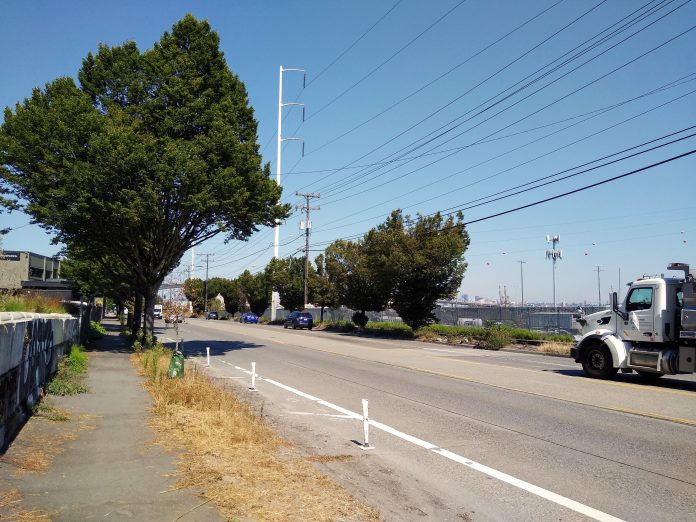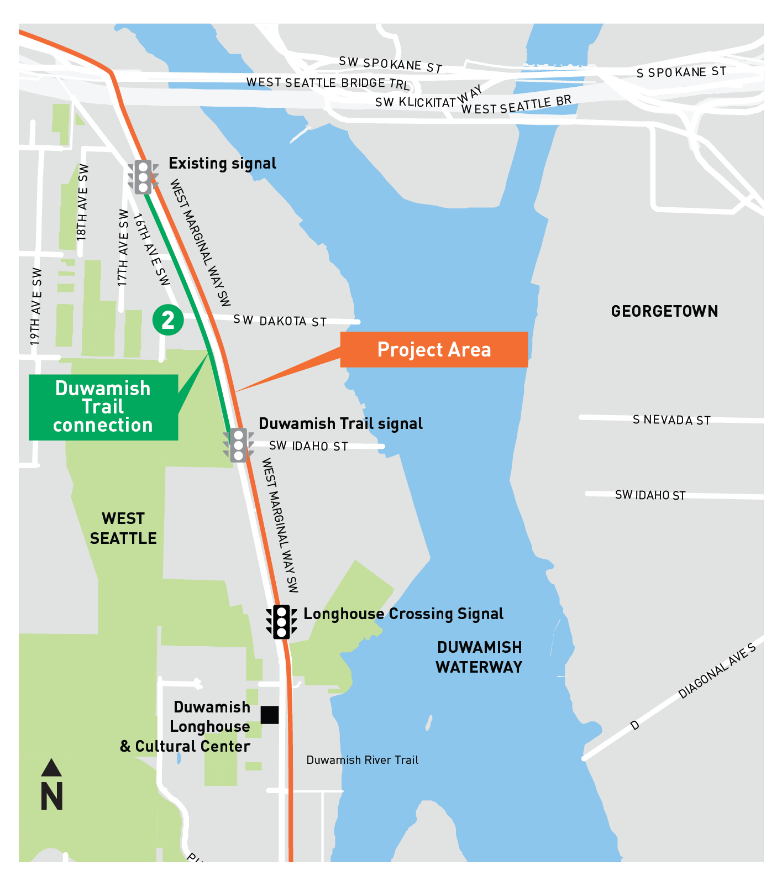
Plans to fill a longtime gap in protected bike infrastructure between the Duwamish Trail to South Park and the West Seattle Bridge Trail hit another roadblock this year, as the Bruce Harrell administration announced that it will be reassessing the elements of a protected bike lane (PBL) on West Marginal Way SW following the opening of the West Seattle Bridge later this month. Under the Jenny Durkan administration, the Seattle Department of Transportation (SDOT), had announced that the project’s construction would be delayed until after the bridge opened, a concession to freight interests who have raised concerns about the project’s potential impact on traffic along the corridor.
The news was originally announced by SDOT in May, but newly obtained records paint the full picture of the reasons behind the closure. “After the bridge reopens, we’ll conduct an additional round of data collection and analysis. We anticipate traffic will return to pre-closure patterns on West Marginal Way once the high bridge is open, and we’ll be analyzing the corridor to inform final design,” the May announcement stated. “Transportation data to be collected (after the West Seattle Bridge opens) includes: Vehicle speeds, Traffic volumes, Walking and biking counts, [and] Safety assessment of driveways and intersections.”
The West Marginal Way PBL will utilize a lane along a segment of street that already narrows to one southbound lane both north and south of the project site. Data SDOT presented on the project last year showed that only 20% of southbound traffic was utilizing the lane intended to become a bike lane, but several groups, including a previous iteration of the Seattle Freight Advisory Board and the Port of Seattle, still cited concerns about impacts to freight traffic as well as concerns about visibility for freight trucks entering and exiting driveways along the street.

Last month, the Cascade Bicycle Club included the West Marginal Way connection on its list of the top five most important projects to make Seattle safer for biking, along with projects like the Georgetown to SoDo connection and the final gap of bike trail along the waterfront. “Filling the gap with an on-street protected bike lane is imminently do-able, but keeps getting postponed. This route matters. We’re making sure the city doesn’t let this project fall off the list,” the blog post states.
“It’s on our top five because it’s not on other people’s radar. At least from my personal perspective, if not from an organizational perspective, it is an equity issue. It is a link, a connection between South Park and the rest of the city,” Lee Lambert, Cascade Bicycle Club’s executive director, told me this week. “And it’s a relatively small gap in the network, and if you’ve had a chance to be down there, you understand its importance in making riding from South Park into West Seattle or downtown simple, safe, and connected.”
In addition to scrutiny from Mayor Harrell’s office, concerns about the project have also been raised by newly elected citywide councilmember Sara Nelson, who mentioned concerns about the project along with some controversial comments where she appeared to downplay the number of people killed while biking in Seattle in 2021, at a meeting of the Queen Anne Community Council in March.
Emails obtained by The Urbanist show that this past May, Nelson received a newsletter from Councilmember Lisa Herbold’s office that mentioned the East Marginal Way Corridor Improvement project, a separate, much more expensive project on the other side of the Duwamish river. Nelson, confusing this for the West Marginal Way project, forwarded the email to SDOT’s city council liason, Bill LaBorde. “Bill, this segment in CM Herbold’s newsletter makes it sound like the lane closure is a done deal. Is that a fair conclusion? You told me it was in the design phase. As I told you, and unless my as-yet unscheduled bike ride with [Cascade Bicycle Club] changes my mind, I have concerns about this project’s impacts on freight mobility and air quality. What are the opportunities for Council to weigh in, if any?”
LaBorde clarified the two projects for the councilmember, and provided an update on West Marginal. “After meeting with the Port, the Mayor has asked us to further evaluate concerns they raised about driveway crossings and traffic concerns for the West Marginal PBL project, some of which we’ll need to perform after the high [West Seattle Bridge] reopens,” he wrote. It’s not clear exactly how Nelson, who has not prioritized transportation issues so far during her term on the city council, became concerned with the West Marginal project.
Several months after it was proposed, Councilmember Nelson finally went on a biking tour with Cascade Bicycle Club along the corridor just this week. “A lot of times these projects get talked about as lines on paper. And there is a powerful understanding that comes when you’re on this existing infrastructure as a vulnerable user and you get to experience it in that way,” Lambert told me ahead of the tour. “I have faith in that when people do this that a protected bike lane for 0.4 miles is better than the current infrastructure.”
It remains to be seen whether the tour will shift Nelson’s views on the project. Ultimately, it will be up to SDOT and the Mayor’s Office, not Councilmember Nelson, to determine if the data on the ground after the opening of the West Seattle bridge aligns with moving this project forward and completing this small but important connection between Seattle’s regional trail network. For bike safety advocates, however, the sooner this piece of the bike network is filled in and SDOT can move on to the other major gaps that exist, the better.
Ryan Packer has been writing for The Urbanist since 2015, and currently reports full-time as Contributing Editor. Their beats are transportation, land use, public space, traffic safety, and obscure community meetings. Packer has also reported for other regional outlets including BikePortland, Seattle Met, and PubliCola. They live in the Capitol Hill neighborhood of Seattle.

